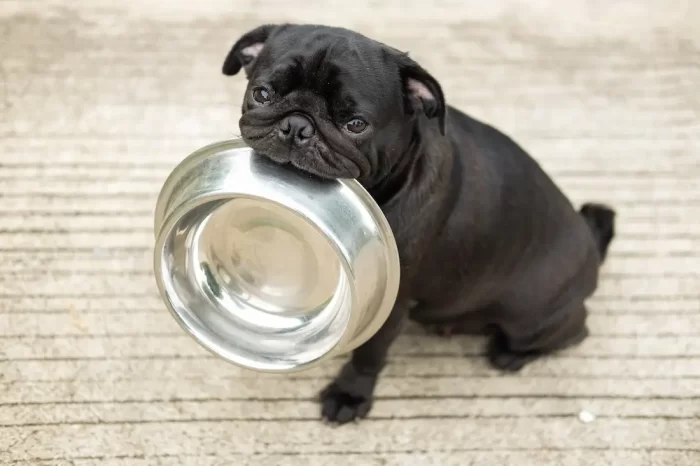Pugs are one of the most popular dog breeds, and for good reason. These compact, affectionate dogs make wonderful companions. However, pugs also come with some unique health considerations that owners need to be aware of. Proper nutrition is key to keeping your pug healthy and happy. In this article we talk about Pug Nutrition Guide for 2024-What Every Pug Owner Needs to Know.
Table of Contents
The Importance of Good Nutrition for Pugs

Good nutrition is essential for all dogs, but it’s especially critical for brachycephalic (short-nosed) breeds like pugs. Pugs are prone to a number of health issues, many of which can be managed or prevented with appropriate diet and lifestyle choices. Obesity, dental disease, skin problems, breathing issues, and gastrointestinal problems are some of the main health concerns facing pugs. Feeding your pug a nutritious, species-appropriate diet tailored to their unique needs can go a long way in supporting their health and quality of life.
Pug Nutritional Needs: Macronutrients
When it comes to the specific nutritional needs of pugs, it’s helpful to break it down into macronutrients (protein, fat, carbohydrates) and micronutrients (vitamins, minerals).
Protein is arguably the most important macronutrient for pugs. High-quality protein provides amino acids that support the maintenance and repair of muscle, organs, and other tissues. Look for a dog food that lists a high-quality animal-based protein (such as chicken, lamb, or fish) as one of the first few ingredients.
Fat is another key nutrient that provides concentrated energy. Choose a dog food with moderate fat levels to meet your pug’s energy needs while avoiding obesity. Sources like chicken fat, fish oil, and nut oils also provide omega fatty acids to nourish your pug’s skin and coat health.
Carbohydrates provide easily accessible energy, fiber, and key nutrients. Look for whole, complex carbs like brown rice, barley, sweet potatoes, peas, and lentils rather than simple carbs like corn or wheat. Fiber is especially important for digestive health.
Micronutrients: Vitamins, Minerals, and More
In addition to macronutrients, pugs also need ample micronutrients in their diet. These include:
- Vitamin A for vision, immune function, skin health, and more
- B vitamins for energy metabolism
- Vitamin C for collagen production, wound healing, and immune function
- Vitamin E to nourish skin health
- Calcium and phosphorus for bone health
- Selenium, zinc, iron and copper for immune health and metabolism
- Omega-3 and omega-6 fatty acids for skin/coat health and to reduce inflammation
Reputable commercial dog foods contain added vitamins and minerals to meet your pug’s needs. You can also provide micronutrients by incorporating fresh fruits and vegetables into your pug’s diet. More on that later!
How Much and How Often?
So you know what key nutrients to look for, but how much should you actually feed your pug? There are a few factors to consider when determining portion sizes:
- Life stage: Puppies, adolescents, and senior pugs have different calorie needs.
- Size: Larger pugs need more food than smaller pugs.
- Activity level: Active pugs need more food than couch potato pugs.
- Health conditions: Issues like obesity may require calorie restriction.
Most commercial dog foods provide feeding guidelines on the label based on your dog’s weight and life stage. This is a good starting point, but you’ll need to adjust up or down depending on their unique needs.
As a general rule, most adult pugs should be fed 1⁄2 to 1 cup of quality dog food divided into two meals per day. Puppies may need three to four small meals spaced throughout the day. Pay attention to your individual pug’s body condition and energy levels, increasing or decreasing the amount fed as needed to maintain ideal body weight.
Choosing the Best Dog Food for Your Pug
With so many dog food options on the market, how do you choose the best one for your pug? Here are some things to look for:
- AAFCO statement: This ensures the food meets standards established by the Association of American Feed Control Officials for complete and balanced nutrition.
- High-quality animal protein: Chicken, turkey, lamb, fish, and eggs are digested well. Avoid corn, soy, wheat, by-products.
- Moderate fat and carbs: Look for food with less than 4,000 kcal/kg and low-glycemic carbs like brown rice, barley, peas.
- Omega fatty acids: Nutrient-rich fats nourish skin and coat. Look for omega-3s and omega-6s.
- Probiotics and prebiotics: Support healthy digestion and immunity.
- Fruits and vegetables: Supply vitamins, minerals, fiber, and antioxidants..
- Limited ingredients: Helps identify food intolerances. Avoid artificial preservatives.
- Appropriate kibble size: Choose small bites easier for little pug mouths to chew.
Pay attention to how well your pug tolerates a particular food. Signs of gastrointestinal upset like vomiting, diarrhea, or excessive gas could indicate an issue.
Homemade and Raw Diets
While commercial complete and balanced diets are suitable for most pugs, some owners prefer to feed homemade or raw food diets. These non-traditional diets allow for more control over ingredient quality. However, formulating homemade meals that fulfill all of your pug’s nutritional needs takes care and planning. Work closely with your veterinarian and a veterinary nutritionist to develop balanced recipes tailored to your pug’s health status before switching them to a homemade diet.
Treats and Supplements for Pugs
Treats and supplements can be a healthy addition to your pug’s diet when chosen wisely. Try these nutritious options:
Treats
- Carrots and green beans
- Lean meat or fish
- Low-fat cheese
- Blueberries and strawberries
- Peanut butter (no xylitol)
Supplements
- Glucosamine/chondroitin for joints
- Probiotics for digestion
- Fish oil for skin/coat health
- Vitamin E and C
Avoid overtreating, which can quickly lead to weight gain or nutritional imbalances. Stick to small portions of healthy treats, limiting to 10-15% of their daily caloric intake at most. Only give supplements if recommended by your vet for a specific condition.
Exercise and Weight Management for Pugs
Proper nutrition also goes hand-in-hand with an active lifestyle. Though they aren’t endurance athletes, pugs still need daily exercise to maintain a healthy weight and prevent obesity. Aim for at least 20-30 minutes of activity per day. Low-impact activities like short walks, playing fetch, or running around the yard are best for the pug’s compact body structure. Keep walks short and slow to prevent overheating and difficulty breathing.
Weigh your pug regularly to monitor for weight gain and make diet adjustments as needed. You should be able to easily feel (but not see) your pug’s ribs without pressing. Extra weight stresses joints and breathing, so keep your pug fit and trim!
In Conclusion
From puppyhood through their senior years, feeding your pug the right diet in the right amounts is one of the most loving things you can do as their owner. Pay attention to their unique nutritional needs, adjust as needed based on activity level and health status, treat them judiciously, and keep up daily exercise. Follow these fundamental feeding guidelines to enjoy many happy, healthy years together with your pug. I sincerely hope you find this “Pug Nutrition Guide for 2024-What Every Pug Owner Needs to Know” article helpful.


